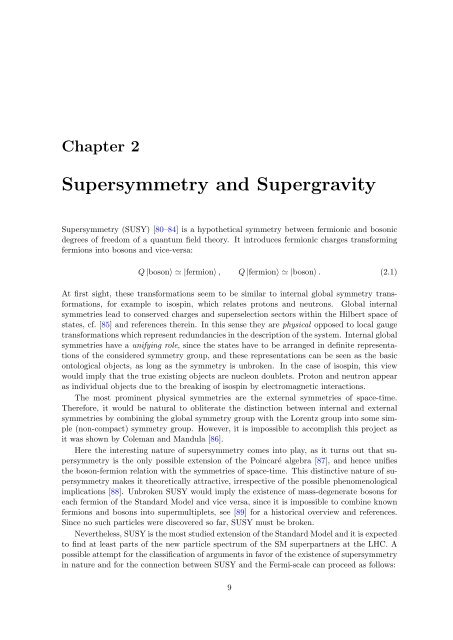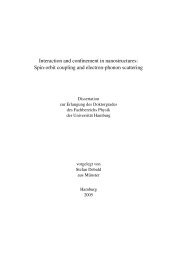Gravitinos and hidden Supersymmetry at the LHC - Universität ...
Gravitinos and hidden Supersymmetry at the LHC - Universität ...
Gravitinos and hidden Supersymmetry at the LHC - Universität ...
You also want an ePaper? Increase the reach of your titles
YUMPU automatically turns print PDFs into web optimized ePapers that Google loves.
Chapter 2<br />
<strong>Supersymmetry</strong> <strong>and</strong> Supergravity<br />
<strong>Supersymmetry</strong> (SUSY) [80–84] is a hypo<strong>the</strong>tical symmetry between fermionic <strong>and</strong> bosonic<br />
degrees of freedom of a quantum field <strong>the</strong>ory. It introduces fermionic charges transforming<br />
fermions into bosons <strong>and</strong> vice-versa:<br />
Q |boson〉 ≃ |fermion〉 , Q |fermion〉 ≃ |boson〉 . (2.1)<br />
At first sight, <strong>the</strong>se transform<strong>at</strong>ions seem to be similar to internal global symmetry transform<strong>at</strong>ions,<br />
for example to isospin, which rel<strong>at</strong>es protons <strong>and</strong> neutrons. Global internal<br />
symmetries lead to conserved charges <strong>and</strong> superselection sectors within <strong>the</strong> Hilbert space of<br />
st<strong>at</strong>es, cf. [85] <strong>and</strong> references <strong>the</strong>rein. In this sense <strong>the</strong>y are physical opposed to local gauge<br />
transform<strong>at</strong>ions which represent redundancies in <strong>the</strong> description of <strong>the</strong> system. Internal global<br />
symmetries have a unifying role, since <strong>the</strong> st<strong>at</strong>es have to be arranged in definite represent<strong>at</strong>ions<br />
of <strong>the</strong> considered symmetry group, <strong>and</strong> <strong>the</strong>se represent<strong>at</strong>ions can be seen as <strong>the</strong> basic<br />
ontological objects, as long as <strong>the</strong> symmetry is unbroken. In <strong>the</strong> case of isospin, this view<br />
would imply th<strong>at</strong> <strong>the</strong> true existing objects are nucleon doublets. Proton <strong>and</strong> neutron appear<br />
as individual objects due to <strong>the</strong> breaking of isospin by electromagnetic interactions.<br />
The most prominent physical symmetries are <strong>the</strong> external symmetries of space-time.<br />
Therefore, it would be n<strong>at</strong>ural to obliter<strong>at</strong>e <strong>the</strong> distinction between internal <strong>and</strong> external<br />
symmetries by combining <strong>the</strong> global symmetry group with <strong>the</strong> Lorentz group into some simple<br />
(non-compact) symmetry group. However, it is impossible to accomplish this project as<br />
it was shown by Coleman <strong>and</strong> M<strong>and</strong>ula [86].<br />
Here <strong>the</strong> interesting n<strong>at</strong>ure of supersymmetry comes into play, as it turns out th<strong>at</strong> supersymmetry<br />
is <strong>the</strong> only possible extension of <strong>the</strong> Poincaré algebra [87], <strong>and</strong> hence unifies<br />
<strong>the</strong> boson-fermion rel<strong>at</strong>ion with <strong>the</strong> symmetries of space-time. This distinctive n<strong>at</strong>ure of supersymmetry<br />
makes it <strong>the</strong>oretically <strong>at</strong>tractive, irrespective of <strong>the</strong> possible phenomenological<br />
implic<strong>at</strong>ions [88]. Unbroken SUSY would imply <strong>the</strong> existence of mass-degener<strong>at</strong>e bosons for<br />
each fermion of <strong>the</strong> St<strong>and</strong>ard Model <strong>and</strong> vice versa, since it is impossible to combine known<br />
fermions <strong>and</strong> bosons into supermultiplets, see [89] for a historical overview <strong>and</strong> references.<br />
Since no such particles were discovered so far, SUSY must be broken.<br />
Never<strong>the</strong>less, SUSY is <strong>the</strong> most studied extension of <strong>the</strong> St<strong>and</strong>ard Model <strong>and</strong> it is expected<br />
to find <strong>at</strong> least parts of <strong>the</strong> new particle spectrum of <strong>the</strong> SM superpartners <strong>at</strong> <strong>the</strong> <strong>LHC</strong>. A<br />
possible <strong>at</strong>tempt for <strong>the</strong> classific<strong>at</strong>ion of arguments in favor of <strong>the</strong> existence of supersymmetry<br />
in n<strong>at</strong>ure <strong>and</strong> for <strong>the</strong> connection between SUSY <strong>and</strong> <strong>the</strong> Fermi-scale can proceed as follows:<br />
9

















